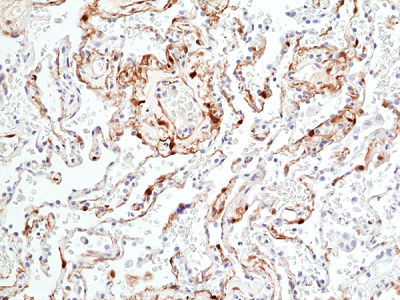Phospho ERK1 + ERK2 Antibody Duo (Total, pT202/Y204)
ARG30264
TargetMAPK1
Product group Antibodies
Overview
- SupplierArigo Biolaboratories
- Product NamePhospho ERK1 + ERK2 Antibody Duo (Total, pT202/Y204)
- Delivery Days Customer23
- CertificationResearch Use Only
- Gene ID5594
- Target nameMAPK1
- Target descriptionmitogen-activated protein kinase 1
- Target synonymsERK, ERK-2, ERK2, ERT1, MAPK2, NS13, P42MAPK, PRKM1, PRKM2, p38, p40, p41, p41mapk, p42-MAPK, mitogen-activated protein kinase 1, MAP kinase 1, MAP kinase 2, MAPK 2, extracellular signal-regulated kinase 2, mitogen-activated protein kinase 2, protein tyrosine kinase ERK2
- Scientific DescriptionERK1 is a member of the MAP kinase family. MAP kinases, also known as extracellular signal-regulated kinases (ERKs), act in a signaling cascade that regulates various cellular processes such as proliferation, differentiation, and cell cycle progression in response to a variety of extracellular signals. This kinase is activated by upstream kinases, resulting in its translocation to the nucleus where it phosphorylates nuclear targets. Alternatively spliced transcript variants encoding different protein isoforms have been described. [provided by RefSeq, Jul 2008]ERK2 is a member of the MAP kinase family. MAP kinases, also known as extracellular signal-regulated kinases (ERKs), act as an integration point for multiple biochemical signals, and are involved in a wide variety of cellular processes such as proliferation, differentiation, transcription regulation and development. The activation of this kinase requires its phosphorylation by upstream kinases. Upon activation, this kinase translocates to the nucleus of the stimulated cells, where it phosphorylates nuclear targets. One study also suggests that this protein acts as a transcriptional repressor independent of its kinase activity. The encoded protein has been identified as a moonlighting protein based on its ability to perform mechanistically distinct functions. Two alternatively spliced transcript variants encoding the same protein, but differing in the UTRs, have been reported for this gene. [provided by RefSeq, Jan 2014]
- Storage Instruction-20°C
- UNSPSC12352203






